VSP(Voight-Schneider Propeller)

The Voight-Schneider Propeller is an application of cycloidal propulsion. It provides excellent maneuverability and high efficiency:
The Voith-Schneider Propulsion
The Voith [sic] Schneider Propeller is a ship propulsion system that allows optimum maneuverability!
The blades of the prop rotate constantly in one direction with a constant revolution speed. The Blades are connected to the point "N" which is not rotating with the rest of the rotor. If "N" moves out of the center of the prop the angle of every blade is changing during one revolution.
Stearing the ship is as easy as putting "N" into any position! The more "N" is away from "0" the more power is provided by the prop.
If you want more info about Voith-Schneider props, or even want to build one by yourself please refer to one of these books:
Kurt Benz: "Der Voith Schneider Propeller als Schiffsmodellantrieb"
ISBN 3-922414-10-9
Verlag fuer Technik und Handwerk Gmbh
Robert Bosch Str. 4
76532 Baden Baden
Telefon (07221)5087-0, Telefax(07221)5087-52
Theodor Vieweg: "Der VSP-Antrieb im Schiffsmodell"
ISBN 3-7883-187-2
Neckar Verlag GmbH
Klosterring 1
Postfach 1820
78008 Villingen-Schwenningen
Germany
Telefon (07721)8987-0,
Telefax (07721)8987-50

Here is the PDF from the manufacturer: http://www.voithturbo.com/media/vtmh_am_specialprint_1930_e.pdf
On a Voith-Schneider Propeller the blades project below the ships hull and rotate about a vertical axis, having an oscillatory motion about its own axis superimposed on this uniform motion. Compared to a classic screw , the functioning of the Voith-Schneider propeller is more difficult to explain.
Blade movements on opposite sides of the propeller
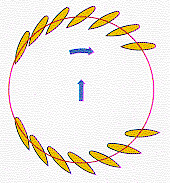
The functioning is more easily understood if you consider only those VSP blade positions within which thrust is generated.
The blade's oscillating movement - a non-stationary process in hydrodynamic theory - determines the magnitude of thrust through variation of the amplitude, the phase correlation determining the thrust direction between 0 and 360 degrees. Therefore there is no preferred direction. A fish's fin action not only produces a force in the direction of motion but simultaneosly forces normal to that direction during a fish's steering force. In nature many animals use such movement and in this way optimally adapted to their living environment.
By superimposing the rotary movement of the propeller on a straight line perpendicular to the rotational axis (to represent the movement of the vessel), the blade of the Voith-Schneider Propeller follows a cycloid.
Actual path of one blade :

"Skulling" is known by every sailor -a movement where by oscillating the
paddle transversely in the direction of motion and produces the thrust to move the boat.
The hydrodynamic principle of the blade action are produced mechanically by the "heart" of VSP: the kinematics.
1 Lower spherical bush
2 Link
3 Bearing pin
4 Crank
5 Connecting rod
6 Actuating lever
neutral position // thrusting position
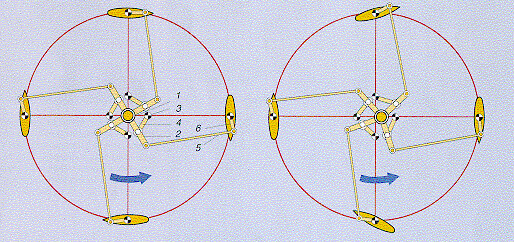
The hydrodynamic principle of the blade action are produced mechanically by the "heart" of VSP: the kinematics.

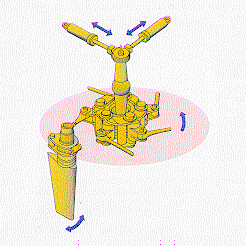
The figure shows a vertical bodycut of a type "G" propeller with crank type kinematics.
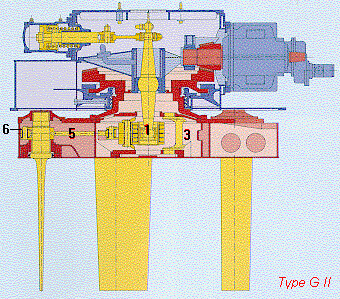
Voight's Patents
[caption id="" align="aligncenter" width="343" caption="patent"]
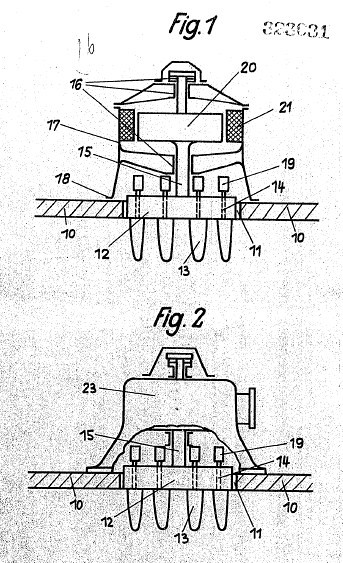 [/caption]
[/caption]





I'm truly enjoying the design and layout of your blog. It's a very easy on the eyes which makes it much more enjoyable for me to come here and visit more often.
BalasHapusDid you hire out a developer to create your theme? Excellent work!
Also visit my blog post - click the next document
nice design
BalasHapusharga kipas angin besar
Kipas besar